I had a blast in New York City and was awed by the magnitude of the skyline!
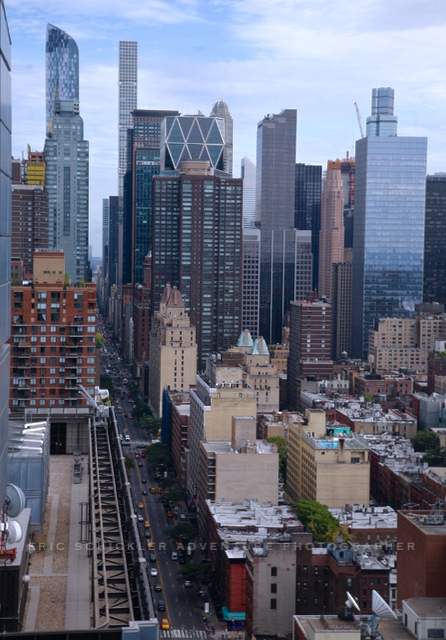

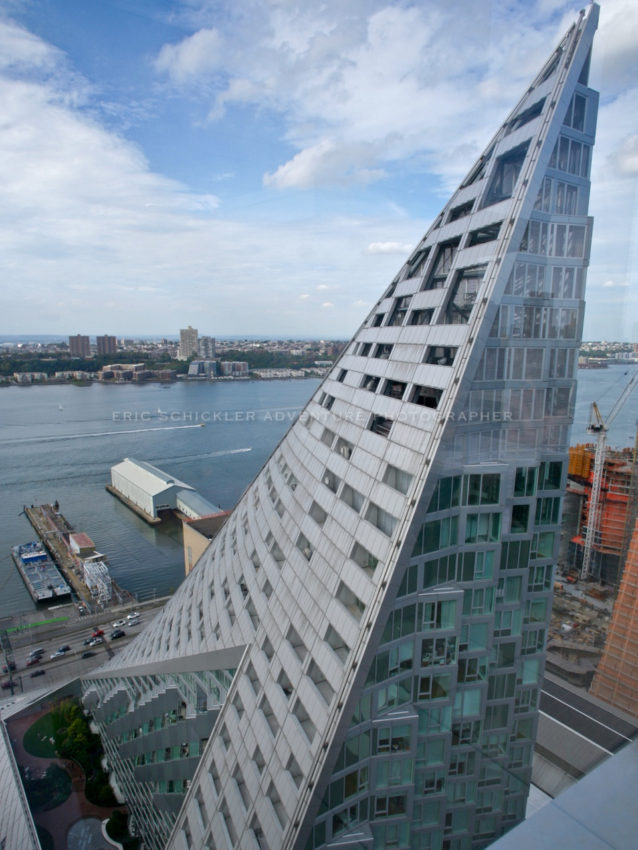

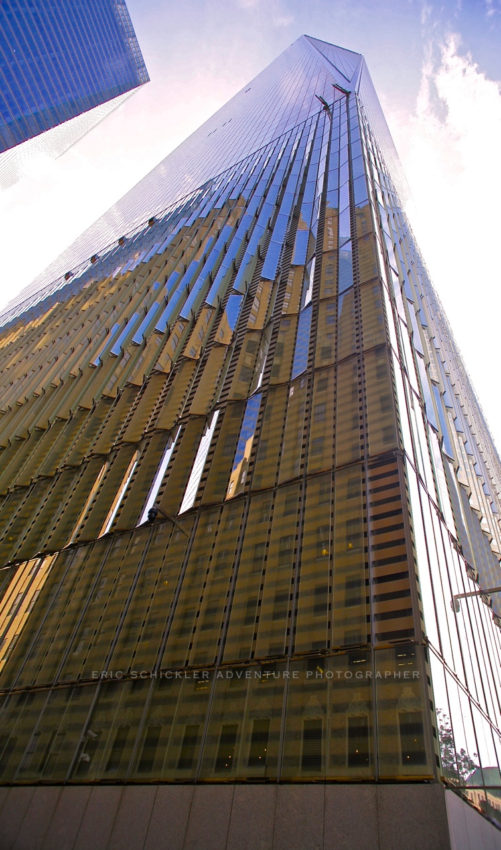
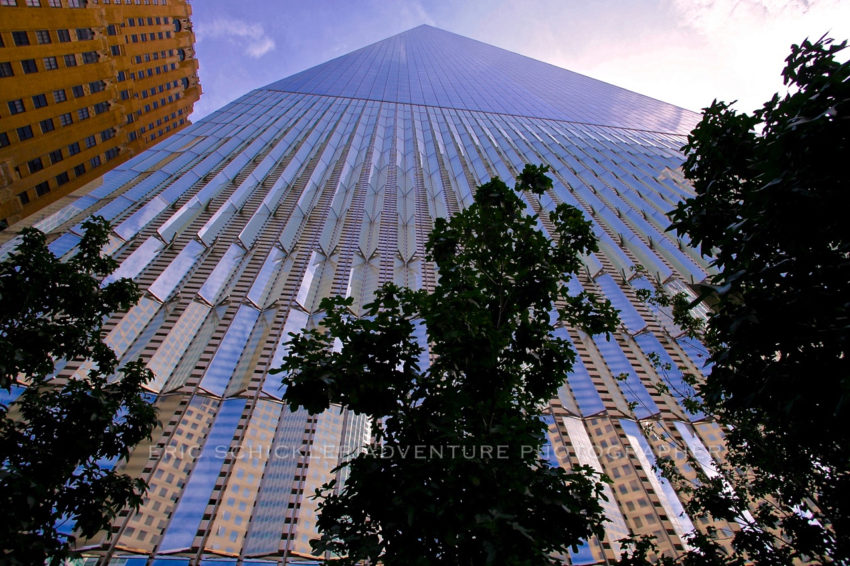
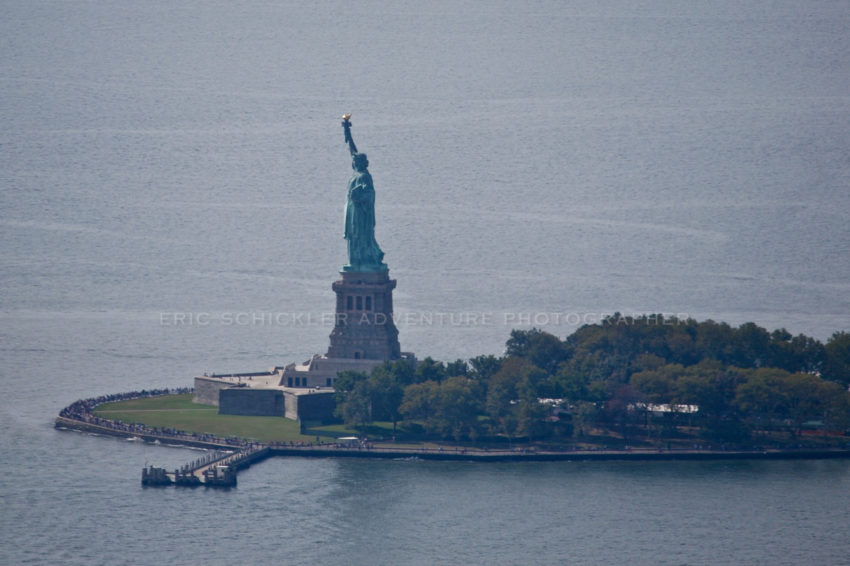



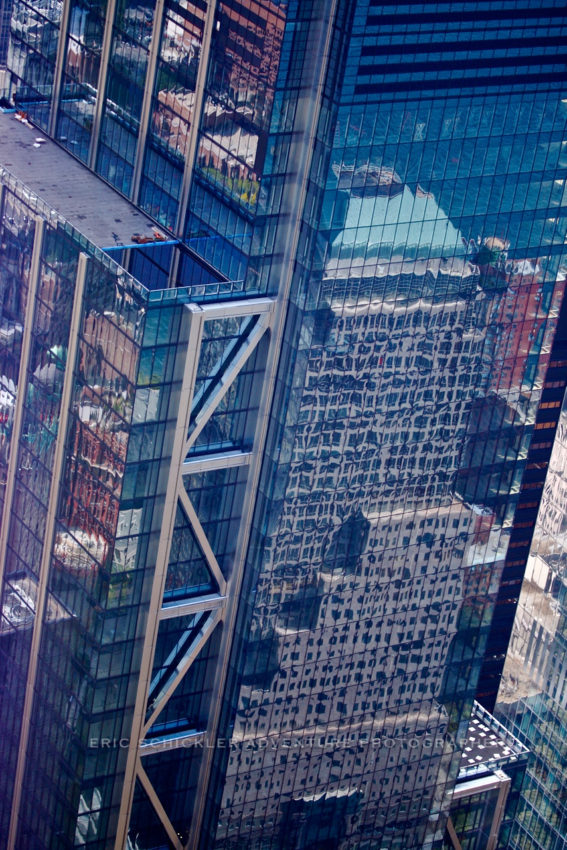







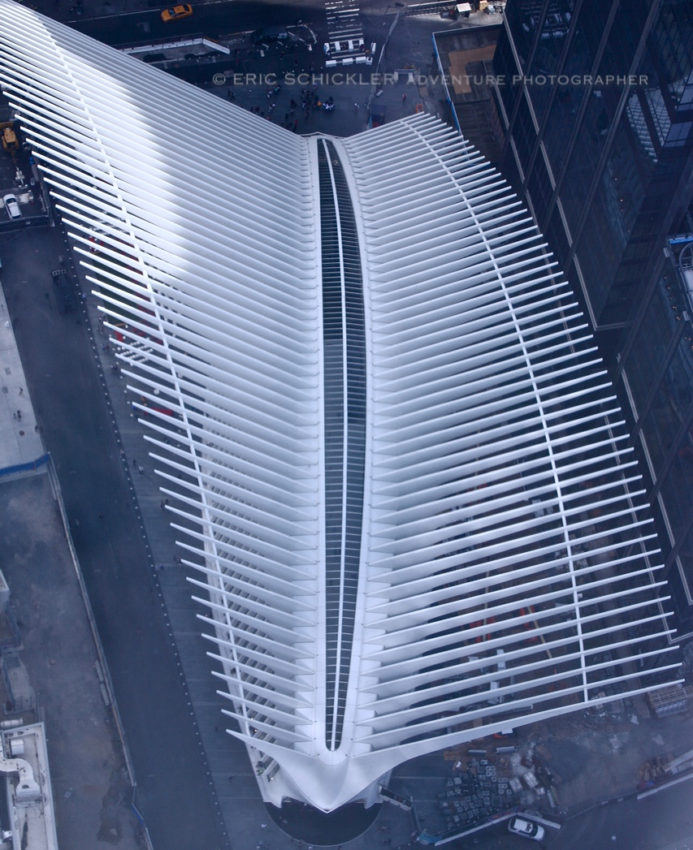
Adventure Photographer Eric R. Schickler
Let's Take It Outside!



















Editor’s Note: This is an excerpt from Eric Schickler’s full-length travelogue, “Costa Rica’s Osa Peninsula”
_______________
Iguana Lodge
Pura Vida was on our minds when our driver found the hidden gem named Iguana Lodge, an eco-resort operated ironically by two former trial attorneys from Colorado, where we live.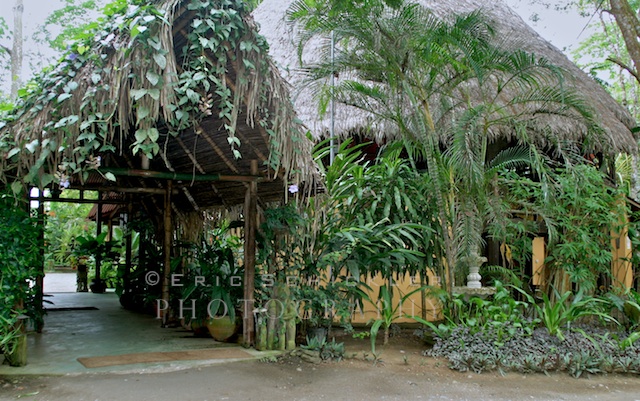 Nestled contently in the tropical rainforest, just a few hundred yards from the beaches of Golfo Dulce, the small lodge fosters a tranquil, sedate, relaxed feeling. It is an isolated and private oasis where no oasis is even needed—in the middle of a massive tropical paradise.
Nestled contently in the tropical rainforest, just a few hundred yards from the beaches of Golfo Dulce, the small lodge fosters a tranquil, sedate, relaxed feeling. It is an isolated and private oasis where no oasis is even needed—in the middle of a massive tropical paradise.
Our home for the next week was situated just a few hundred feet off the finest beach on the Osa, Playa Platanares (locals call it “Playa Preciosa”).
My friend and traveling companion, Ana, and I were greeted with mango daiquiris and another “Pura Vida,” this time from someone in a colorful sarong with a warm smile and fresh flowers, and much better looking than the burly judge-and-jury, baggage-weighing pilot.
“I am Maureen. Welcome to Iguana Lodge.”
“We are so happy to be here,” said Ana.
 “Mucho gusto,” was the reply from our greeter. (“With much pleasure!” – “My pleasure” – “Thank you.”)
“Mucho gusto,” was the reply from our greeter. (“With much pleasure!” – “My pleasure” – “Thank you.”)
We got a quick tour of the quaint resort, checked into our casita, unpacked our 27-lb. backpacks (a five-minute task), and giggled about where we were. I looked at Ana and squealed, “Let’s go!”
Like two five-year-olds bolting from the classroom on the final day of school, we scooted 200 yards down a shaded, meticulously manicured path.
It was a living corridor of plants, flowers and all kinds of broad-leaf trees. Before we could say Robinson Crusoe, we emerged from our tunnel and onto the beach. A very deserted beach.
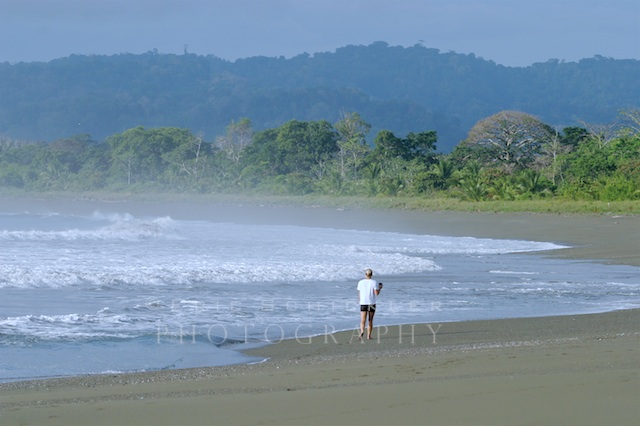
The hectic pace of the travel day had just melted away. With our minds and bodies at ease, our seaside jungle experience was underway. It was just one hour after our plane landed on the Osa, and “Pura Vida” had already sunk in.
We explored the beach for hours, unwinding more with every step.
We came upon a river outlet, and walked inland slightly to explore. Beyond the tree line was an enticing lagoon, but its sole proprietor greeted us as we approached. A large caiman, looking for lunch! We moved back toward the gulf rather quickly, hoping to extend our vacation beyond the first two hours. Now we knew why they highly recommend using guides whenever you venture off into the jungle. The beach would be just fine for now.
 Back near the lodge, we found the secret trail, dipped back into the dense wall of trees, and it was Garden of Eden time.
Back near the lodge, we found the secret trail, dipped back into the dense wall of trees, and it was Garden of Eden time.
The warm humid breeze gently tossed the palm fronds and supple plants to and fro, creating a kaleidoscope scattering of soft light.
Butterflies and birds of all colors and sizes danced on the dense air. Reptiles slithered in the ground cover. Monkeys rattled the branches above us. A large iguana crawled slowly along a tree branch, munching away at the foliage.
A brightly colored waterbird sipped from the lodge’s stone fountain, which was surrounded by a garden of vibrant flowers, including the unmistakable bird of paradise.
All this tropical adventure and sensory overload was making us hungry. We geared up for one of the resort’s most talked-about features–its food. Iguana Lodge offers outstanding international cuisine and local fare. The creative meals feature fresh, healthy ingredients, and the cuisine has attracted rave reviews, ranking among the best in all of Costa Rica.
The breakfasts featured incomparable Costa Rican coffees, considered some of the richest, most aromatic and most flavorful on Earth. Then came our Adam & Eve experience. A giant tray was brought out from the kitchen, loaded with a cavalcade of local fruit treasures: fresh cut mangoes, papayas, melons, pineapples and bananas.
Then came our Adam & Eve experience. A giant tray was brought out from the kitchen, loaded with a cavalcade of local fruit treasures: fresh cut mangoes, papayas, melons, pineapples and bananas.
Next came entrees like eggs benedict, huevos rancheros with rice & beans, and banana crepes. And finally, the sinful homemade pastries. Then more delicious coffee.
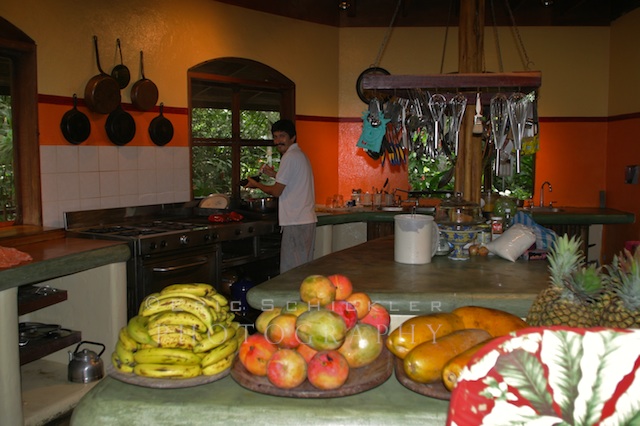
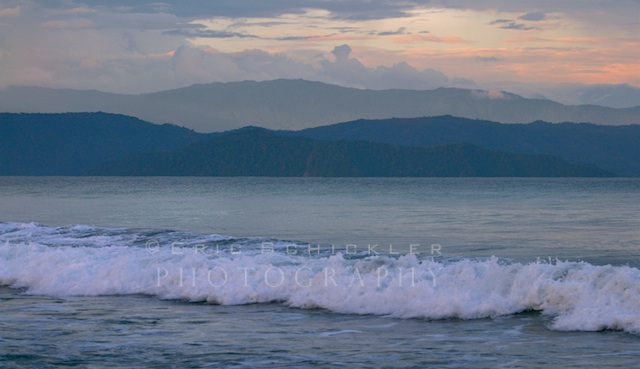 Later in the week, before leaving the country, we would take a tour of the Cafe Britt Factory that produced this fine coffee in Heredia, just north of San Jose.
Later in the week, before leaving the country, we would take a tour of the Cafe Britt Factory that produced this fine coffee in Heredia, just north of San Jose.
We were treated to educational, humorous and theatrical presentations that took our knowledge of coffee to a new slow-roasted level. This tour has become one of the country’s most popular.
We learned the history of coffee, the growing and harvesting processes, how it is manufactured and the best way to brew and drink it. We also enjoyed complimentary coffee the entire time we were there. Despite the tour’s three-hour duration, I can’t recall one person getting sleepy.
 This was not your average dining experience at the lodge.
This was not your average dining experience at the lodge.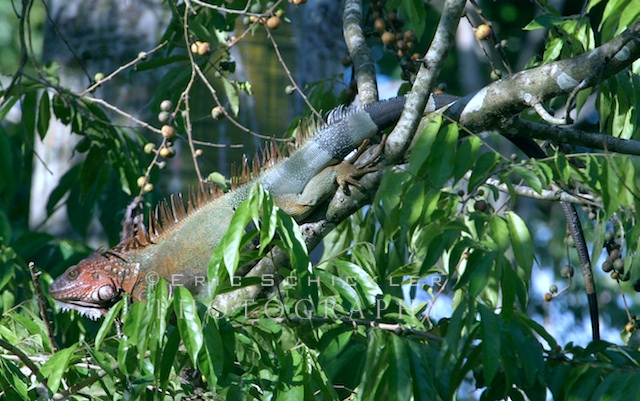
Breakfast was enjoyed on the outside verandas, where just feet away tropical birds rustled about in the rain forest canopy, emitting so many varieties of songs and chirps and whistles you felt a symphony was warming up in the distance.
A male mantled howler monkey broke the morning calm with its baritone roars, causing more than a few startled guests to spill their treasured coffee. If these animals don’t remind you that you’re in the jungle, nothing will. They are found in great numbers in Costa Rica, and are best known for their resounding howls, audible for a half-mile or more. They are very vocal at dusk and dawn and, like dogs, will also howl at thunder, planes and humans.
After the howler settled down and the fresh fruit and pancakes arrived at our table, the serenity was again shattered, this time by the Osa Peninsula “Air Patrol,” approaching from up the beach.
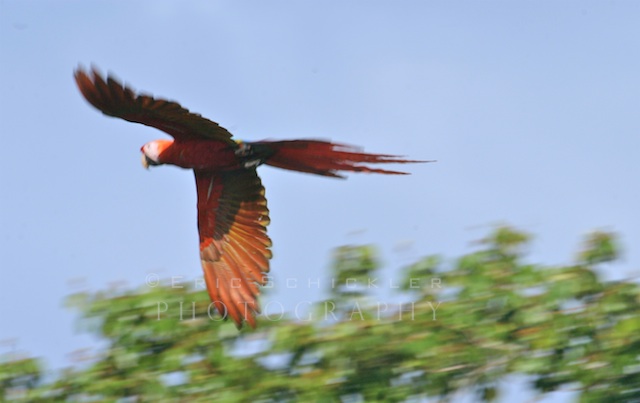 The raucous, inescapable signature squawks, coming from two large scarlet macaws, startled us as much as the howler monkey.
The raucous, inescapable signature squawks, coming from two large scarlet macaws, startled us as much as the howler monkey.
We always knew when they were cruising the tree line near the beach, and we knew when they had passed by. Reminded me of an ambulance with its siren blazing—impossible to ignore. They are often seen in pairs “patrolling” the beaches, landing in the very tall almond trees and enjoying their fine bounties.
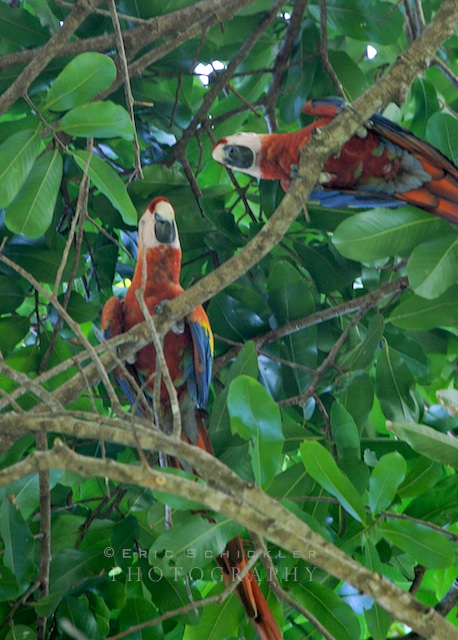 They are quiet when feeding in the treetops, are very difficult to get near and rarely, if ever, come down low in the canopy.
They are quiet when feeding in the treetops, are very difficult to get near and rarely, if ever, come down low in the canopy.
The Iguana Lodge Resort was situated around a main lodge called “Rancho Grande.” It is a two-level, open-air building that looks as if it grew from the forest floor, with native hardwoods, ornamental woods, bamboo trim, and a towering thatched roof.
Its large open kitchen was always bustling with activity; cooks meticulously cutting up the fresh fruits and vegetables that were brought in daily. The upper-level great room was used for quiet relaxation, happy hours and gourmet dinners. A large cooler was stocked with juices, champagne, wine and beer, and was a popular place to visit.
Guests simply recorded what they consumed on the “Honor Bar” Drink Register. At week’s end you pay a lump sum for your total. The running joke all week among the guests was betting on which couple would have the most painful bar tab.
We stayed in one of just a handful of cozy two-story casitas (or cabinas), set on pillars and nestled in the dense forest.
The casitas’ decks had inviting cushioned bamboo furniture and a relaxing hammock, shaded under flowering tropical plants and trees.
Inside was a large and luxurious mosquito-netted bed, screened walls, and artistically designed “garden bathrooms” with semi-open outdoor showers. We discovered rather quickly and happily that insects and mosquitoes were quite scarce.
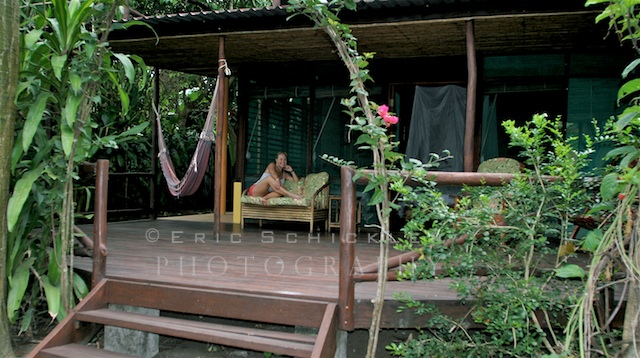
But somehow an occasional tree frog, crab or gecko would sneak in to visit. We found out why the next morning. The resident cats stay busy all day chasing the geckos along the resort’s trails, an entertaining side show for us while we’d swing lazily in the hammock during afternoon siesta.
The resort does have electricity, but a portion of the power reserves are from sun-powered generators. Most of the lighting at night is with candles. This creates quite the ambiance.
New amenities added recently have brought a touch of luxury and culture to the resort. Guests can now exercise in a 65-foot lap pool, frolic in a jacuzzi, hit either of two salsa dance & yoga studios, kick back for some peaceful reading in the library and browse in the art gallery.
After experiencing guided outdoor adventures and activities during the day throughout the peninsula, guests gathered at dark (about 6 p.m. year-round due to our proximity to the Equator).
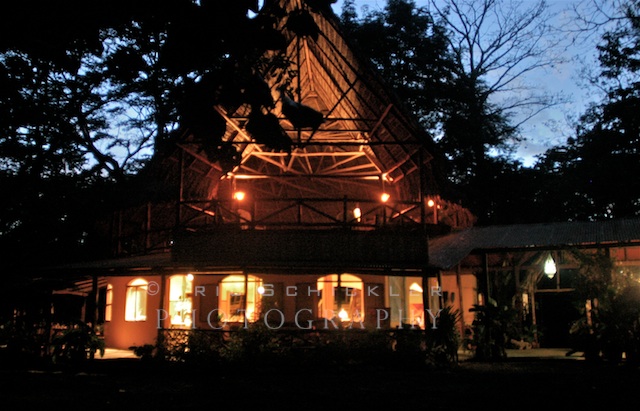 Guests who caught fish on deep-sea fishing excursions often added their catches to the culinary mix, so every night was a different seafood surprise.
Guests who caught fish on deep-sea fishing excursions often added their catches to the culinary mix, so every night was a different seafood surprise.
The atmosphere at dinner was totally “Gilligan’s Island,” inherent in both the people present and the interior atmosphere of the lodge. In places like this, you can always spot “Marianne,” “The Professor,” a “Ginger” or two, “The Skipper,” a “Mr. & Mrs. Howell,” and of course, “Gilligan.”
Nightfall coincided with dinner. All of the resort’s 24 guests gathered around four long tables, which were arranged in a large square formation. A high number of candles ringed the tables, and represented the primary source of light. It created a rich, warm, comfortable atmosphere, spawning robust conversation.
Stories that started at happy hour continued through dinner. So many colorful anecdotes of the day’s adventures at sea, in the trees, on the beach, in boats, on kayaks, on ropes and or on horses–many becoming more embellished as the wine flowed.
Each night we sat next to different guests, so by week’s end we had become acquainted with nearly every cast member from Gilligan’s Island.
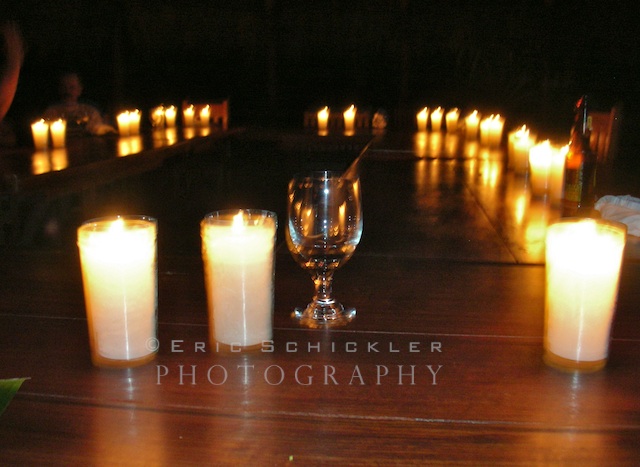
______________________________
To continue the travelogue, click here to go to Part 4
© www.AdventurePhotographer.us
All photography, text and artwork seen here is copyright-protected and the exclusive property of Eric Schickler Adventure Photographer. No downloading, use, reproduction, manipulation, sale and/or distribution permitted without express written consent.
Union Station: the Alpha and The Omega
After a harrowing slide down the mountain in my trusted Mazda MX-6, I lugged my ski gear across the frozen parking lot, slipping on the fresh snow. (Better to slip on my feet, I thought, than off a mountain road in my car).
The fallen snow had created a scenic white cityscape, unusual in Denver even in the middle of winter, and made Union Station look more prominent and historic than ever, its monstrous white-stoned bulk lurking in the foggy haze. Its juxtaposition in a relatively open area of Lower Downtown allows it to be seen like a statue in the center of a courtyard, from a greater distance and more perspectives than is usually afforded in tight city street grids. Its classic 1914 architecture makes it stand out in a downtown district that sees a new building pop up almost monthly.
The large lighted red letters that crown the building boldly announce where you are, and in a circus-attraction manner, promote a specific mode of transportation as if it were the latest fad worthy of curious exploration — “UNION STATION — TRAVEL by TRAIN.” It reminded me of the entrance to Disneyland or the inviting allure of the lettering over an amusement park. It was definitely a throwback to the past. But that was part of the charm.
The station is indeed a testament to Denver’s colorful, historic past, when train travel was the fastest and most comfortable way to get around. And as we are learning, the station will again become a bustling transportation hub and social center for Denver. Will it become the giant it once was, or become even more magnificent, as its history and crucial location are blended with new commercial and residential development, travel technology and a myriad of visitors from even more distant lands? The dark quiet morning gave way to the glow of warm lights and activity in and around the terminal. The massive arched windows above the entrance beckoned me inside, as did the warmth of its cavernous hollow. I slipped into its massive hull, inhaled, swallowed up — like a wandering fish by a giant whale.
My lonely drive from the foothills into the deserted city streets gave way to an instant feeling of connection as I let the doors close behind me. Connection to the city, connection to people wide awake at 6:30 a.m., to the rail tracks that ran along the rear of the building, and to faraway destinations at the other end of the tracks. I was thankful for the activity and my senses were awakened. A wave of warm air met my frozen forehead, condensation formed on my eyeglasses, then my friends approached with a hot cup of coffee and warm greetings. Conversations quickly shifted to the nature of the approaching voyage we would make together.
Footstep echoes flittered across the grand atrium, mingling with muted, yet excited voices. Bundled-up children sat restlessly in the long wooden pews, as if they were about to witness a church service. But the facial expressions were not those you’d see as old Father Murphy marched past them to the alter. They were more like those you’d see on Christmas morning. The eager hum among the children grew with each passing minute. Even grown adults exuded child-like anticipation and excitement.
Everyone readied themselves and their baggage for boarding the quarter-mile-long train for the 7 a.m. departure for the mountains. Most city rail stations would see a 7 a.m. train screech to a halt, fill up quickly, depart, only to be followed within minutes by the same ritual, another train. With short visits from only two Amtrack trains per day, however, the activity around Denver’s Union Station today is like the flickering flame on the wick of a near-empty oil lamp. It’s akin to life in a western ghost town, where a smattering of weekend tourists provide enough commerce for seclusion-hungry locals to cling to a bare-bones existence.
The stark, expansive room seemed haunted with its early 1900’s decor and rich ambient history. In the few minutes I had before boarding, I imagined what it was like to be a child lost in the middle of a bustling throng of Depression-era travelers, filing in and out if the station during its heydays when nearly 80 trains a day pulled in and out. What a contrast to life at Union Station at the very end of the 20th century. Union Station stood as a static relic, an anomaly in Denver’s revitalized and vibrant Lower Downtown district. An unprecedented surge in LoDo’s economic activity was ignited by the 1995 opening of Coors Field. It was followed by widespread residential and commercial development, new businesses, sports, entertainment and cultural attractions, restaurants, galleries and shops. But the decline in rail travel and train commerce had relegated Union Station to a shadow of the activity center it once was.
On this day, as the snow continued to fall, Union Station was as busy as it ever gets. It was a weekend in the winter, so the two daily Amtrack trains would be complemented by the Rio Grande Ski Train, which carries passengers to Winter Park Resort for a day of downhill fun or sightseeing, as it has for 60 years. People rave about the Ski Train. It’s a must for every Coloradan.
I had driven from Evergreen to Denver before dawn, and would go back up the hill later that evening. Was all that effort worth a train ride? I was joining a group of friends for the excursion, my first ever on the Ski Train. I was just as excited as any of the children making their first trip. And I was just going for the ride — I had a broken heel at the time and could not ski. That made no difference. The best parts of the day are the train rides.
On the train, I delighted in the fact that I and 749 others were sitting back enjoying the passing countryside, instead of clinging white-knuckled to my steering wheel as I maneuvered snow-packed I-70, U.S. 40 and Berthoud Pass. For two hours, we rode 56 comfortable miles, climbing 4,000 feet in elevation, passing through 28 tunnels. Then we approached the final mountain underpass, the 6.2-mile-long Moffat Tunnel, the highest railroad tunnel in the U.S.
But for some reason, the visit to historic Union Station was the most memorable part of my day. That building was the first and last impression of my trip, and it dawned on me that it’s the place where you say goodbye and hello, where you cry, smile and hug loved ones. Union Station is like the old worn leather cover of a great novel. The start and the finish, with so many memories in between. And you always end up sharing it with someone you love.
The last time I traveled any great distance by train was 1987 in New York State. After visiting Union Station and taking that ride on the Ski Train, I now think differently. I’ll look for an excuse to ride the train, and take my friends. Recent security concerns in airline travel have forced people to think again about rail travel. I’ve been thinking about it ever since I first walked into Union Station on that wintry morning.
Oh, getting back to my question…. Was it worth all that effort just to ride a train? Oh yes. To ride a train and visit Union Station. When it comes to trains, the journey is the reason you ride, but I just love going through that station.
* All photos in this article (except sunrise image) courtesy of Denver’s Union Station and The Ski Train.
______________________________________
© Eric Schickler Photography, Communication & Design